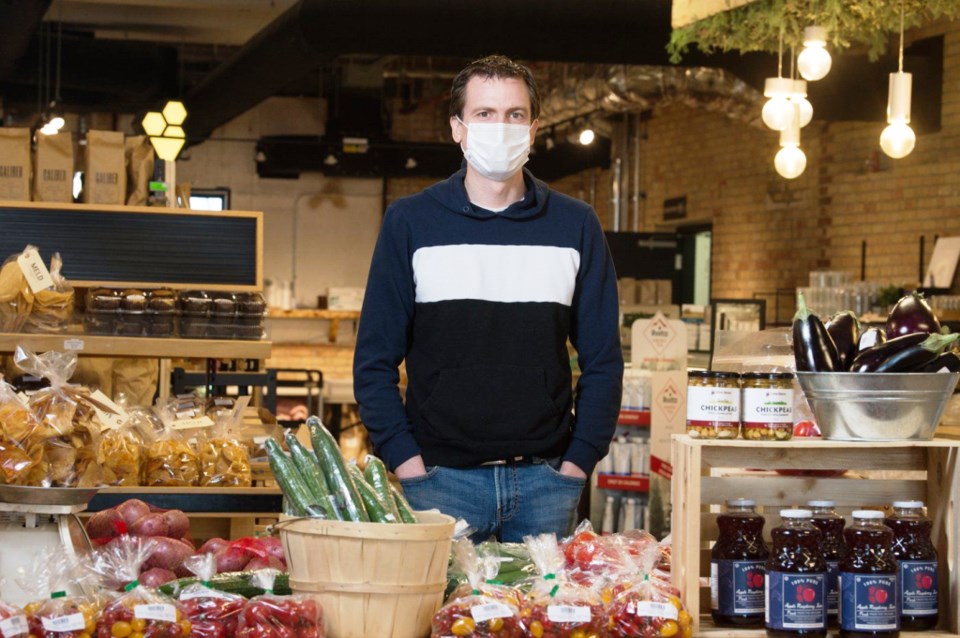If there was a time to follow the oft-used phrase about placing proverbial eggs in many baskets, former farmer Tim Shultz figures year one of the COVID-19 pandemic was it.
The Regina business owner’s restaurant profits rose and fell because of intermittent, changing dine-in restrictions, but his grocery store revenues kept going up. “Our home-delivery service really exploded on us,” he said of his shop, Local & Fresh, first opened in 2014. “We hired two new positions for delivery.”
Shultz and his wife Carla own and run Local Market, a multi-venue business working out of an old, brick warehouse building just off Regina’s Broad Street. It offers event space rentals, a dine-in café and restaurant serving local fixings and the grocery store.
Despite the erratic economic surges brought by the pandemic — mad rushes on toilet paper, constant demand for new bikes and outdoor toys, fast-paced rural property sales — Saskatchewan’s agriculture sector, in which the Shultzes play an important retail role, injected some stability and a bit of growth to the volatile times, particularly with local food.
The Shultzes stock approximately 85 to 90 per cent of Saskatchewan-produced items at their store. “The remainder is all Canadian,” Tim said. “For the most part we’re working directly with the producers.”
Some of those items include roasted lentil snacks from Saskatoon’s Three Farmers, various meat cuts from Schultz’s Ranch Country Meats in Morse and produce from Floating Gardens in Osler and Cedar Creek Gardens on the south side of Regina. “We have over 100 different producers we buy from," he said.
When the province imposed a sweeping lockdown across Saskatchewan last year in March, “almost overnight we saw a large increase (of demand),” he said.
“We had a delivery infrastructure in place already,” allowing the shop to handle the sudden uptick in home-delivery orders. “That really brought awareness to our company and the support stayed as the pandemic went on,” Tim added.
Event-booking and dine-in eating revenues took a hit, but grocery profits told a different story.
“Not quite double the revenue, but close to that,” Tim said. Though he added he was projecting growth for 2020, even before the emergence and spread of COVID-19.
The producers he buys from told him the first year of the pandemic and its initial surging demand caught them off-guard, too.
“They were having to (reduce or cut short) supply to certain stores, because they just didn't have enough. Talking to them over the winter they were planning on growing more” for 2021, he said.
At Saskatoon’s Three Farmers, co-owner and CEO Natasha Vandenhurk says the first year of the pandemic has been stable, yielding revenue losses and gains dictated by particular retail areas, what she called “channels.”
“We've seen an increase in demand through grocery outlets,” like the well-known national chains, coupled with “a softening in demand in certain channels that are shut down — whole foods stores, airports and convenience stores,” she said.
Founded in 2011, Three Farmers markets its pulse-based snack line — roasted chickpeas, lentils and yet-to-be-released faba beans — to people Vandenhurk says are health-conscious, perhaps living active lifestyles or want natural foods.
Most of the pulse crops they source are from Saskatchewan, she said.
The last year of the pandemic also brought “a softening in sort of health snacking; there's definitely been a lot of indulgence going on …in terms of more lockdowns … a skew toward more comfort eating,” meaning high-fat and artificial sugar-type foods.
Thanks to the March 2020 lockdown, the company’s web sales “more than doubled on Amazon overnight and on Costco.ca.”
The initial digital surge leveled off, but for the rest of 2020, the pandemic raised overall “e-commerce sales,” Vandenhurk added.
Looking to the remainder of this year and beyond, she said her company is starting to follow that diversification-many-basket cliche, expanding its market share into the United States.
Canada’s response to the pandemic prompted that, she said. “We're certainly lagging in terms of moving through this pandemic, especially if we look at our neighbours to the south.”
They’ve hired “two new strategic positions” for opening U.S. markets as they hope to target health-conscious demographics via "retail partners.”
Similarly, food security and distribution researcher Sylvain Charlebois says scaling up is a key requirement for Saskatchewan-made food to be sustainable over time and size.
As an example, he said when an exhausted parent — further stretched by the pandemic — hits up a national-chain grocery store, searching out a locally-sourced food item is likely not the first thing they think about.
Charlebois, a Dalhousie University professor, thinks scaling up local products would go a long way for Saskatchewan building “capacity to support a food-autonomy strategy for its citizens.”
Producers and the provincial government ought to think about feeding other jurisdictions, like Alberta and Manitoba, he said. “To actually keep unit prices at a very low level, and make those products competitive on the market in Saskatchewan and not allow someone from California to come in with cucumbers or leafy greens at half price, you want to be able to build economies of scale.”
He believes “people in Saskatchewan aren't necessarily well-served by the agri-food economy they have.” Getting there, Charlebois said, would mean 15 per cent of all products produced in Saskatchewan is consumed here too.
At Regina's Local & Fresh, Shultz too sees how the pandemic highlighted the opportunity for the local food scene to scale up.
“The smaller-scale producer that is able to produce for the market right here at home: That market is really growing and has a ton of potential,” he said, adding it's worthwhile to consider food security in the event of future global disruptions.
“I think the pandemic shone some light on the fragileness of our food system. If a border was to get shut, what happens? Are we able to produce what we need to produce here in Canada?
"It really encouraged people to throw their support behind local producers,” he said.




